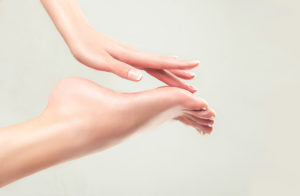 Have you ever found yourself hesitant to shake another person’s hand because yours is so sweaty? What about struggling to walk with flip-flops on because the bottoms of your feet are slick with sweat? Does sweat pour from your hands and feet no matter what the temperature is outside, or no matter how nervous you may feel in the moment?
Have you ever found yourself hesitant to shake another person’s hand because yours is so sweaty? What about struggling to walk with flip-flops on because the bottoms of your feet are slick with sweat? Does sweat pour from your hands and feet no matter what the temperature is outside, or no matter how nervous you may feel in the moment?
If you have found yourself in these or similar situations, chances are you may be more than just a little extra sweaty—you may unknowingly be living with palmar (hand) or plantar (foot) hyperhidrosis. It is a common condition that currently impacts about 7.8 million Americans.
Simply put, hyperhidrosis—also known as polyhidrosis —is excessive sweating in one or multiple parts of the body, most commonly the hands, feet and underarms (axillary). This type of sweating is the result of overactive nerves in the sympathetic nervous system. When functioning normally, these nerves help the body thermoregulate (cool down) by telling the glands when to excrete sweat.
There are two types of hyperhidrosis:
Sweating of the hands or feet, because it is localized, falls under primary focal hyperhidrosis.
Though they are both triggered by the same issue with hyperactive nerves, patients with these conditions face different challenges.
Palmar Hyperhidrosis
Sweaty hands are a lot harder to hide than sweaty feet. While sweaty feet may be tucked away in closed shoes, hands are out for everyone to see—and feel. From intimate moments with a loved one to a friendly high-five or professional handshake, your hands are an intricate part of your day-to-day living.
Additionally, everything you touch—from paper to a smart device—is subject to ruin by the sweat dripping from your hands. Even common everyday activities like holding the steering wheel to drive or buttoning a shirt can be frustrating (and potentially dangerous) and require a towel on-hand at all times.
Plantar Hyperhidrosis
Living with excessively sweaty feet is no better. Shoes and socks alike, even when made of the most breathable material, will likely be ruined over time by the amount of sweat your haywire nerves force your glands to produce (and there are 250,000 sweat glands on a pair of feet).
Along with that, your feet are constantly at risk to both becoming odorous as well as infected due to the environment sweating creates in your shoe: wet and dark, which odor-producing and infectious bacteria and fungal organisms love. Also, walking on any hard, smooth surface with sweat on your feet has the potential to end in a disaster.
Thankfully, despite their differences, both palmar and plantar hyperhidrosis can often be managed with the same treatments. These include:
Surgery for Hyperhidrosis
In addition to the above treatments, a procedure known as an endoscopic transthoracic sympathectomy (ETS) may also be recommended by our specialists for patients with palmar hyperhidrosis. ETS is a minimally invasive procedure where a surgeon divides the sympathetic nerve chain that triggers the glands in the hands. This same-day procedure results in dry, warm hands immediately, providing a permanent solution for patients suffering from palmar hyperhidrosis
While ETS is not recommended for patient suffering from plantar hyperhidrosis in isolation, we have seen many cases in which it improves after the procedure when palmar hyperhidrosis also exists. Many patients have seen anywhere from decrease in their plantar sweating to complete resolution of the condition.
If you’re living with either (or both) of these conditions, place your treatment in the hands of professionals who have been helping hyperhidrosis patients for years and pioneered techniques to help treat it. Contact the Hyperhidrosis Center at Thoracic Group today.